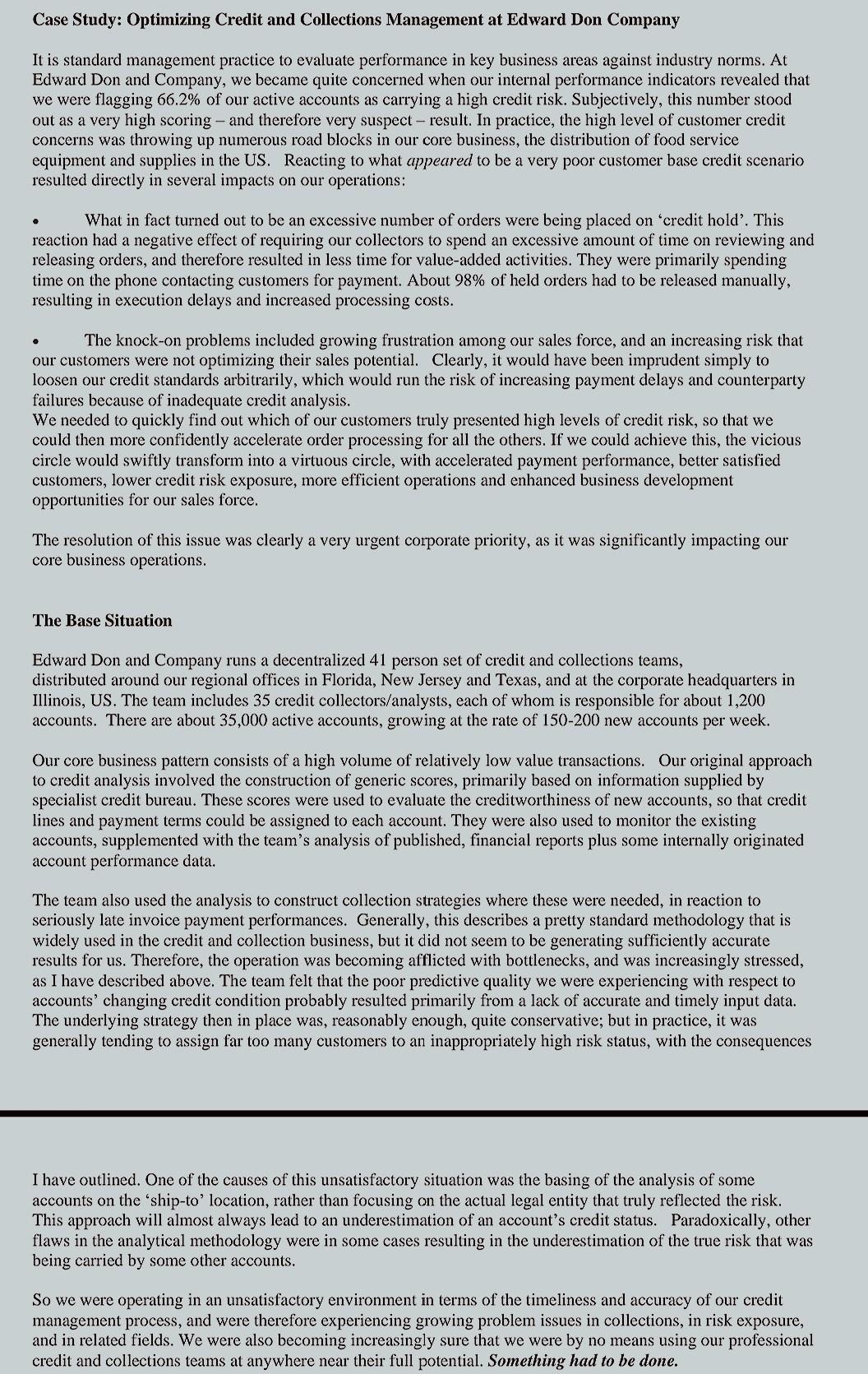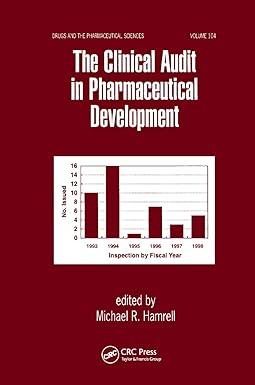Answered step by step
Verified Expert Solution
Question
1 Approved Answer
question : 1. Proposed Solution (specific and realistic solution) 2. Recommendation/s (Based on your answer in No. 1 recommend the best solution/s. Discuss specific strategies

question : 1. Proposed Solution (specific and realistic solution) 2. Recommendation/s (Based on your answer in No. 1 recommend the best solution/s. Discuss specific strategies to accomplish the recommended solution, Recommend further action to resolve some of the issues)
3. Thesis Statement
Case Study: Optimizing Credit and Collections Management at Edward Don Company It is standard management practice to evaluate performance in key business areas against industry norms. At Edward Don and Company, we became quite concerned when our internal performance indicators revealed that we were flagging 66.2% of our active accounts as carrying a high credit risk. Subjectively, this number stood out as a very high scoring - and therefore very suspect - result. In practice, the high level of customer credit concerns was throwing up numerous road blocks in our core business, the distribution of food service equipment and supplies in the US. Reacting to what appeared to be a very poor customer base credit scenario resulted directly in several impacts on our operations: What in fact turned out to be an excessive number of orders were being placed on credit hold'. This reaction had a negative effect of requiring our collectors to spend an excessive amount of time on reviewing and releasing orders, and therefore resulted in less time for value-added activities. They were primarily spending time on the phone contacting customers for payment. About 98% of held orders had to be released manually, resulting in execution delays and increased processing costs. The knock-on problems included growing frustration among our sales force, and an increasing risk that our customers were not optimizing their sales potential. Clearly, it would have been imprudent simply to loosen our credit standards arbitrarily, which would run the risk of increasing payment delays and counterparty failures because of inadequate credit analysis. We needed to quickly find out which of our customers truly presented high levels of credit risk, so that we could then more confidently accelerate order processing for all the others. If we could achieve this, the vicious circle would swiftly transform into a virtuous circle, with accelerated payment performance, better satisfied customers, lower credit risk exposure, more efficient operations and enhanced business development opportunities for our sales force. The resolution of this issue was clearly a very urgent corporate priority, as it was significantly impacting our core business operations. The Base Situation Edward Don and Company runs a decentralized 41 person set of credit and collections teams, distributed around our regional offices in Florida, New Jersey and Texas, and at the corporate headquarters in Illinois, US. The team includes 35 credit collectors/analysts, each of whom is responsible for about 1,200 accounts. There are about 35,000 active accounts, growing at the rate of 150-200 new accounts per week. Our core business pattern consists of a high volume of relatively low value transactions. Our original approach to credit analysis involved the construction of generic scores, primarily based on information supplied by specialist credit bureau. These scores were used to evaluate the creditworthiness of new accounts, so that credit lines and payment terms could be assigned to each account. They were also used to monitor the existing accounts, supplemented with the team's analysis of published, financial reports plus some internally originated account performance data. The team also used the analysis to construct collection strategies where these were needed, in reaction to seriously late invoice payment performances. Generally, this describes a pretty standard methodology that is widely used in the credit and collection business, but it did not seem to be generating sufficiently accurate results for us. Therefore, the operation was becoming afflicted with bottlenecks, and was increasingly stressed, as I have described above. The team felt that the poor predictive quality we were experiencing with respect to accounts' changing credit condition probably resulted primarily from a lack of accurate and timely input data. The underlying strategy then in place was, reasonably enough, quite conservative; but in practice, it was generally tending to assign far too many customers to an inappropriately high risk status, with the consequences I have outlined. One of the causes of this unsatisfactory situation was the basing of the analysis of some accounts on the ship-to' location, rather than focusing on the actual legal entity that truly reflected the risk. This approach will almost always lead to an underestimation of an account's credit status. Paradoxically, other flaws in the analytical methodology were in some cases resulting in the underestimation of the true risk that was being carried by some other accounts. So we were operating in an unsatisfactory environment in terms of the timeliness and accuracy of our credit management process, and were therefore experiencing growing problem issues in collections, in risk exposure, and in related fields. We were also becoming increasingly sure that we were by no means using our professional credit and collections teams at anywhere near their full potential. Something had to be doneStep by Step Solution
There are 3 Steps involved in it
Step: 1

Get Instant Access to Expert-Tailored Solutions
See step-by-step solutions with expert insights and AI powered tools for academic success
Step: 2

Step: 3

Ace Your Homework with AI
Get the answers you need in no time with our AI-driven, step-by-step assistance
Get Started


